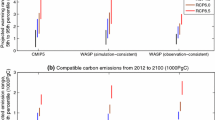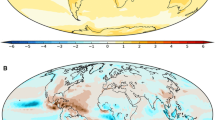Abstract
An ensemble experiment with the IAP RAS CM was performed to estimate future changes in the atmospheric concentration of carbon dioxide, its radiative forcing, and characteristics of the climate-carbon cycle feedback. Different ensemble members were obtained by varying the governing parameters of the terrestrial carbon cycle of the model. For 1860–2100, anthropogenic CO2 emissions due to fossil-fuel burning and land use were prescribed from observational estimates for the 19th and 20th centuries. For the 21st century, emissions were taken from the SRES A2 scenario. The ensemble of numerical experiments was analyzed via Bayesian statistics, which made the uncertainty range of estimates much narrower. To distinguish between realistic and unrealistic ensemble members, the observational characteristics of the carbon cycle for the 20th century were used as a criterion. For the given emission scenario, the carbon dioxide concentration expected by the end of the 21st century falls into the range 818 ± 46 ppm (an average plus or minus standard deviation). The corresponding global instantaneous radiative forcing at the top of the atmosphere (relative to the preindustrial state) lies in the uncertainty range 6.8 ± 0.4 W m−2. The uncertainty range of the strength of the climate-carbon cycle feedback by the end of the 21st century reaches 59 ± 98 ppm in terms of the atmospheric carbon dioxide concentration and 0.4 ± 0.7 W m−2 in terms of the radiative forcing.
Similar content being viewed by others
References
P. M. Cox, R. A. Betts, C. Jones, et al., “Acceleration of Global Warming Due to Carbon-Cycle Feedbacks in a Coupled Climate Model,” Nature 408, 184–187 (2000).
V. Brovkin, J. Bendtsen, M. Claussen, et al., “Carbon Cycle, Vegetation, and Climate Dynamics in the Holocene: Experiments with the CLIMBER-2 Model,” Glob. Biogeochem. Cycles 16, 1139 (2002).
V. Brovkin, S. Sitch, W. von Bloh, et al., “Role of Land Cover Changes for Atmospheric CO2 Increase and Climate Change during the Last 15 Years,” Glob. Change Biol. 10, 1253–1266 (2004).
J.-L. Dufresne, P. Friedlingstein, M. Berthelot, et al., “On the Magnitude of Positive Feedback between Future Climate Change and the Carbon Cycle,” Geophys. Rev. Lett. 29, 1405 (2002).
P. Friedlingstein, J.-L. Dufresne, P. M. Cox, and P. Rayner, “How Positive Is the Feedback between Climate Change and the Carbon Cycle?,” Tellus B 55(2), 692–700 (2003).
C. D. Jones, P. M. Cox, R. L. H. Essery, et al., “Strong Carbon Cycle Feedbacks in a Climate Model with Interactive CO2 and Sulphate Aerosols,” Geophys. Rev. Lett. 30, 1479 (2003).
H. D. Matthews, A. J. Weaver, K. J. Meissner, et al., “Natural and Anthropogenic Climate Change: Incorporating Historical Land Cover Change, Vegetation Dynamics and the Global Carbon Cycle,” Clim. Dyn. 22, 461–479 (2004).
H. D. Matthews, A. J. Weaver, and K. J. Meissner, “Terrestrial Carbon Cycle Dynamics under Recent and Future Climate Change,” J. Clim. 18, 1609–1628 (2005).
B. Govindasamy, S. Thompson, A. Mirin, et al., “Increase of Carbon Cycle Feedback with Climate Sensitivity: Results from a Coupled Climate and Carbon Cycle Model,” Tellus B 57(2), 153–163 (2005).
G. Bala, K. Caldeira, A. Mirin, et al., “Multicentury Changes to the Global Climate and Carbon Cycle: Results from a Coupled Climate and Carbon Cycle Model,” J. Clim. 18, 4531–4544 (2005).
S. Sitch, V. Brovkin, W. von Bloh, et al., “Impacts of Future Land Cover Changes on Atmospheric CO2 and Climate,” Glob. Biogeochem. Cycles 19(2), GB2013 (2005).
I. I. Mokhov, A. V. Eliseev, and A. A. Karpenko, “Sensitivity of the IAP RAS Global Climate Model with an Interactive Carbon Cycle to Anthropogenic Impacts,” Dokl. Akad. Nauk 407, 400–404 (2006).
I. I. Mokhov, V. A. Bezverkhnii, A. V. Eliseev, and A. A. Karpenko, “Model Estimations of Global Climate Changes in the 21st Century with Consideration of Different Scenarios of Variations in Solar Activity,” Dokl. Akad. Nauk 411, 250–253 (2006).
I. I. Mokhov, A. V. Eliseev, and A. A. Karpenko, “Climate-Carbon Cycle Feedback in the 20th and 21st Centuries from Calculations with a Global Climate Model,” in Computational Technologies, Selected Reports of the International Conference on Measurements, Modeling, and Information Systems for Environmental Studies: ENVIROMIS-2006 (Tomsk, 2006), vol. 11,part 2, pp. 156–165 [in Russian].
A. V. Eliseev and I. I. Mokhov, “Sensitivity of Climate-Carbon Cycle Feedback to the Choice of the Determining Parameters of the Land Carbon Cycle in a Climate Model of Intermediate Complexity,” in Computational Technologies, Selected Reports of the International Conference on Measurements, Modeling, and Information Systems for Environmental Studies: ENVIROMIS-2006 (Tomsk, 2006), vol. 11,part 3, pp. 14–19 [in Russian].
A. V. Eliseev and I. I. Mokhov, “Carbon Cycle-Climate Feedback Sensitivity to Parameter Changes of a Zero-Dimensional Terrestrial Carbon Cycle Scheme in a Climate Model of Intermediate Complexity,” Theor. Appl. Climatol. 89(1–2), 9–24 (2007).
A. V. Eliseev, I. I. Mokhov, and A. A. Karpenko, “Climate and Carbon Cycle Variations in the 20th and 21st Centuries in a Model of Intermediate Complexity,” Izv. Akad. Nauk, Fiz. Atmos. Okeana 43, 3–17 (2007) [Izv., Atmos. Ocean. Phys. 43, 1–17 (2007)].
E. M. Volodin, “Atmosphere-Ocean General Circulation Model with the Carbon Cycle,” Izv. Akad. Nauk, Fiz. Atmos. Okeana 43, 298–313 (2007) [Izv., Atmos. Ocean. Phys. 43, 266–280 (2007)].
P. Friedlingstein, P. Cox, R. Betts, et al., “Climate-Carbon Cycle Feedback Analysis: Results from the C4 MIP Model Intercomparison,” J. Clim. 19, 3337–3353 (2006).
J. M. Melillo, P. A. Steudler, J. D. Aber, et al., “Soil Warming and Carbon-Cycle Feedbacks to the Climate System,” Science 298, 2173–2176 (2002).
G. Marland, T. A. Boden, and R. J. Andres, “Global, Regional, and National CO2 Emissions,” in Trends: A Compendium of Data on Global Change Oak Ridge, Tenn. (Carbon Dioxide Information Analysis Center, Oak Ridge National Laboratory, 2005).
R. A. Houghton, “Revised Estimates of the Annual Net Flux of Carbon to the Atmosphere from Changes in Land Use and Land Management 1850–2000,” Tellus B 55(2), 378–390 (2003).
Climate Change 2001: The Scientific Basis. Contribution of Working Group I to the Third Assessment Report of the Intergovernmental Panel on Climate Change, Ed. by J. T. Houghton, Y. Ding, D. J. Griggs, et al. (Cambridge Univ. Press, New York, 2001).
T. M. Lenton, “Land and Ocean Carbon Cycle Feedback Effects on Global Warming in a Simple Earth System Model,” Tellus B 52(5), 1159–1188 (2000).
Climate Change 2007: The Physical Science Basis, Ed. by S. Solomon, D. Qin, M. Manning, et al. (Cambridge Univ. Press, New York, 2007).
K. Ya. Kondrat’ev, “From Nano-to Global Scales: Properties, Processes of Formation and Aftereffect of Impacts of Atmospheric Aerosol: 7. Aerosol Radiation Disturbing Impact and Climate,” Opt. Atmos. Okeana 18, 535–536 (2005).
M. R. Allen, P. A. Stott, J. F. B. Mitchell, et al., “Quantifying the Uncertainty in Forecasts of Anthropogenic Climate Change,” Nature 407, 617–620 (2000).
M. Claussen, L. Mysak, A. Weaver, et al., “Earth System Models of Intermediate Complexity: Closing the Gap in the Spectrum of Climate System Models,” Clim. Dyn. 18, 579–586 (2002).
V. Petoukhov, M. Claussen, A. Berger, et al., “EMIC Intercomparison Project (EMIP-CO2): Comparative Analysis of EMIC Simulations of Current Climate and Equilibrium and Transient Reponses to Atmospheric CO2 Doubling,” Clim. Dyn. 25, 363–385 (2005).
R. E. Kass and A. E. Raftery, “Bayes Factors,” J. Am. Statist. Assoc. 90(430), 773–795 (1995).
J. A. Hoeting, D. Madigan, A. E. Raftery, and C. T. Volinsky, “Bayesian Model Averaging: A Tutorial,” Statist. Sci. 14, 382–401 (1999).
S. S. Leroy, “Detecting Climate Signals: Some Bayesian Aspects,” J. Clim. 11, 640–651 (1998).
C. Tebaldi, L. O. Mearns, D. Nychka, and R. L. Smith, “Regional Probabilities of Precipitation Change: A Bayesian Analysis of Multimodel Simulations,” Geophys. Rev. Lett. 31, L24213 (2004).
C. Tebaldi, R. W. Smith, D. Nychka, and L. O. Mearns, “Quantifying Uncertainty in Projections of Regional Climate Change: A Bayesian Approach to the Analysis of Multi-Model Ensembles,” J. Clim. 18, 1524–1540 (2005).
R. Schnur and K. Hasselmann, “Optimal Filtering for Bayesian Detection and Attribution of Climate Change,” Clim. Dyn. 24, 45–55 (2005).
D. J. Frame, B. B. B. Booth, J. A. Kettleborough, et al., “Constraining Climate Forecasts: The Role of Prior Assumptions,” Geophys. Rev. Lett. 32, L09702 (2005).
The International Ad Hoc Detection and Attribution Group, “Detecting and Attributing External Influences on the Climate System: A Review of Recent Advances,” J. Clim. 18, 1291–1314 (2005).
A. M. Greene, L. Goddard, and U. Lall, “Probabilistic Multimodel Regional Temperature Change Projections,” J. Clim. 19, 4326–4343 (2006).
A. Lopez, C. Tebaldi, M. New, et al., “Two Approaches to Quantifying Uncertainty in Global Temperature Changes,” J. Clim. 19, 4785–4796 (2006).
S.-K. Min and A. Hense, “A Bayesian Assessment of Climate Change Using Multimodel Ensembles. Part I: Global Mean Surface Temperature,” J. Clim. 19, 3237–3256 (2006).
S.-K. Min and A. Hense, “A Bayesian Assessment of Climate Change Using Multimodel Ensembles. Part II: Regional and Seasonal Mean Surface Temperatures,” J. Clim. 20, 2769–2790 (2007).
J. I. House, I. C. Prentice, N. Ramankutty, et al., “Reconciling Apparent Inconsistencies in Estimates of Terrestrial CO2 Sources and Sinks,” Tellus B 55(2), 345–363 (2003).
C. D. Keeling, J. F. S. Chine, and T. P. Whorf, “Increased Activity of Northern Vegetation Inferred from Atmospheric CO2 Measurements,” Nature 382, 146–149 (1996).
C. D. Jones, P. M. Cox, and C. Huntingford, “Climate-Carbon Cycle Feedbacks under Stabilisation: Uncertainty and Observational Constraints,” Tellus B 58(5), 603–613 (2006).
N. B. Melnikov and B. C. O’Neill, “Learning about the Carbon Cycle from Global Budget Data,” Geophys. Rev. Lett. 33, L02705 (2006).
Climate Change 2001: Mitigation. Contribution of Working Group III to the Third Assessment Report of the Intergovernmental Panel on Climate Change, Ed. by B. Metz, O. Davidson, R. Swart, and J. Pan (Cambridge Univ. Press, New York, 2001).
Author information
Authors and Affiliations
Corresponding author
Additional information
Original Russian Text © A.V. Eliseev, 2008, published in Izvestiya AN. Fizika Atmosfery i Okeana, 2008, Vol. 44, No. 3, pp. 301–310.
Rights and permissions
About this article
Cite this article
Eliseev, A.V. Estimation of the uncertainty of future changes in atmospheric carbon dioxide concentration and its radiative forcing. Izv. Atmos. Ocean. Phys. 44, 279–287 (2008). https://doi.org/10.1134/S0001433808030031
Received:
Accepted:
Published:
Issue Date:
DOI: https://doi.org/10.1134/S0001433808030031




